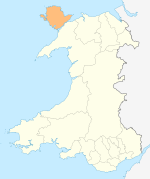Holyhead Breakwater

Holyhead Breakwater is situated at the north-western end of
Background
In the age of sail, northerly winds in the Irish Sea could often prevent ships from Ireland entering the old harbour at Holyhead. When adverse weather conditions halted sailings from Holyhead, passengers and cargo had to be moved to Porth Dafarch on the southerly side of Holy Island. The sheltered bay was used from the mid-17th into the 19th century as an alternative to the main port.[2] The customs post,[3] dating from 1819, can still be seen at Porth Dafarch.
The
By the mid 19th century
Construction

In January 1848 work began under the auspices of superintendent engineer J.M.Rendel.[1][4] Following his death in 1856, the project was completed by John Hawkshaw.[4] Shaped 10-tonne blocks of limestone were used to create an outer facing wall, thereby encasing a rubble mound raised from the sea both by dumping from ships and tipping from the shore.[5] Divers in submarine bells created the level foundations on which the tiers of facing stones were placed.[6] These men worked underwater using picks and hammers, and carried out blasting using gunpowder sealed in watertight tin pipes.[6] Up to 1,300 men were employed during the work; 40 died during construction.[7]
A
The breakwater, which took 28 years to complete, was officially opened on 19 August 1873 by
Since November 2014, concrete blocks have been placed at the entrance to block traffic. However, the breakwater is still accessible to walkers.
Gallery
|
References
- ^ ISBN 978-1-84306-459-6.)
{{cite book}}: CS1 maint: multiple names: authors list (link - ISBN 978-1-4466-0504-2.
- ^ "Old Customs Post, Trearddur, Isle of Anglesey".
- ^ ISBN 0727725769.
- ISBN 1862390290.
- ^ a b Jamieson, Alexander (1879). Dictionary of Mechanical Science, Arts, Manufactures, and Miscellaneous Knowledge, Volume 1. H. Fisher, Son & Company. p. 103.
- ISBN 0-86381-698-3.
- ISBN 1-84527-006-1.
- ^ "Ponta Delgada and the Broad Gauge Harbour Railways". www.internationalsteam.co.uk. Retrieved 24 February 2023.
- ^ "Railways in Açores". www.sinfin.net. Retrieved 24 February 2023.
- ^ Stöckl, Fritz (1961). "The Last 7 ft. Gauge Railway in the World". Railway Magazine. pp. 468–469.
- ^ David Plimmer. "Holyhead Breakwater". www.2d53.co.uk. Retrieved 1 August 2018.









